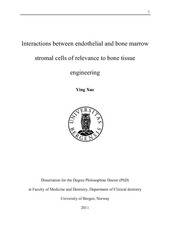| dc.contributor.author | Xue, Ying | en_US |
| dc.date.accessioned | 2011-07-13T11:54:04Z | |
| dc.date.available | 2011-07-13T11:54:04Z | |
| dc.date.issued | 2011-02-04 | eng |
| dc.identifier.isbn | 978-82-308-1691-2 (print version) | en_US |
| dc.identifier.uri | https://hdl.handle.net/1956/4833 | |
| dc.description.abstract | Much research effort is being directed towards the development of bone tissue engineering techniques as alternatives to grafts for the treatment of bone defects. A major challenge is that following implantation of the tissue engineered construct, inadequate vascularity limits the supply of nutrients to the proliferating osteoprogenitor cells within the scaffolding. One proposed means of addressing this issue is the addition of endothelial cells (EC), major components of vessel-formation, to bone marrow stromal cells (MSC) seeded onto a biodegradable scaffold. The aim of the present series of studies was to investigate interactions between endothelial cells and bone marrow stromal cells, with special reference to osteogenic differentiation of MSC and bone formation. In study I, the addition of EC to MSC at a ratio of 1:5 resulted in significant increases in cell proliferation and cellular bridges between the two cell types. At the same time, increased mRNA expression of alkaline phosphatase was observed; this effect was greater than that achieved by the addition of osteogenic factors such as dexamethasone, ascorbic acid and - glycerophosphate to the culture medium. This interesting finding suggests that under conditions of direct contact culturing, endothelial cells influence the osteogenic differentiation of MSC. Study II was designed to select an appropriate copolymer scaffold to support the cells during the initial stages. MSC were seeded onto two porous test scaffolds, made of poly(LLAco- CL) and poly(LLA-co-DXO). The cellular response was determined in terms of attachment, proliferation and differentiation. The results showed that poly(LLA-co-CL) and poly(LLA-co-DXO) promoted better cell attachment and growth than the control scaffolding, poly(LLA). Moreover, MSC retained their osteogenic differentiation potential on the scaffolds. As shown in study I, EC influenced the osteogenic differentiation of MSC. In study III, this effect was investigated in vivo, using a rat calvarial bone defect model to compare bone regeneration by MSC grown in mono- or co-culture. Either bone marrow stromal cells alone (MSC-group) or both types of cell (CO-group) were seeded onto poly(LLA-co-DXO) scaffolds, cultured in spinner flasks and then implanted into symmetrical calvarial defects. After two months, new bone and vessel formation were evaluated by radiography and histology and expression of osteogenic markers by RT-PCR. Bone formation was more rapid in the CO- than in the MSC-group, but no significant differences were detected with respect to vessel formation. Expression of osteogenic markers was greater in the CO- than in the MSC-group. Studies I & III demonstrated a significant effect of co-culture on osteogenesis. Systematic investigation continued in Study IV, namely microarray analysis with the HumanWG-6 v3.0 expression BeadChips, each array representing >48,000 probes. A global map of gene expression after communication between MSC and EC was generated in a direct-contact model. Differentially expressed genes were identified and over-represented genes were annotated by gene ontology and biological processes and pathways. The results indicated that EC had a significant impact on MSC after 5 and 15 days. Of particular interest was the disclosure of bidirectional gene regulation of angiogenesis and osteogenesis through cell signaling, cell adhesion and cellular matrix. The results suggest that the cell-matrix interaction and the TGF-beta signal pathway might play a crucial role in EC-induced gene regulation of MSC. The results of these studies thus support bone tissue engineering concepts based on seeding of MSC and EC onto copolymer scaffolding. Together, the cell culture and animal studies indicate that cross-communication between bone marrow stromal cells and endothelial cells has influenced the osteogenic differentiation as well as enhanced the bone healing. | en_US |
| dc.language.iso | eng | eng |
| dc.publisher | The University of Bergen | eng |
| dc.relation.haspart | Paper I: BioMedical Engineering OnLine 8(34), Xue, Y.; Xing, Z.; Hellem, S..; Arvidson, K.; Mustafa, K., Endothelial cells influence the osteogenic potential of bone marrow stromal cells. Copyright 2009 Xue et al; licensee BioMed Central. Reproduced with permission. Published version. The published version is also available at: <a href="http://dx.doi.org/10.1186/1475-925X-8-34" target="_blank">http://dx.doi.org/10.1186/1475-925X-8-34</a> | en_US |
| dc.relation.haspart | Paper II: Journal of Biomedical Materials Research Part A 95A(4), Xue, Y.; Dånmark, S.; Xing, Z.; Arvidson, K.; Albertsson, A. C.; Hellem, S.; Finne-Wistrand, A.; Mustafa, K., Growth and differentiation of bone marrow stromal cells on biodegradable polymer scaffolds: an in vitro study, pp. 1244-1251. Copyright 2010 Wiley Periodicals. Full text not available in BORA due to publisher restrictions. The published version is available at: <a href="http://dx.doi.org/10.1002/jbm.a.32945" target="_blank">http://dx.doi.org/10.1002/jbm.a.32945</a> | en_US |
| dc.relation.haspart | Paper III: Journal of Biomedical Materials Research Part A 96A(2), Xing, Z.; Xue, Y.; Dånmark, S.; Schander, K.; Østvold, S.; Arvidson, K.; Hellem, S.; Finne- Wistrand, A.; Albertsson, A. C.; Mustafa, K., Effect of endothelial cells on bone regeneration using poly(L-lactide-co-1,5-dioxepan-2-one) scaffolds, pp 349-357. Copyright 2010 Wiley Periodicals. Full text not available in BORA due to publisher restrictions. The published version is available at: <a href="http://dx.doi.org/10.1002/jbm.a.32989" target="_blank"> http://dx.doi.org/10.1002/jbm.a.32989</a> | en_US |
| dc.relation.haspart | Paper IV: Xue, Y.; Bolstad, A. I.; Hellem, S.; Arvidson, K.; Mustafa, K., 2011, Gene expression profiles of human bone marrow stromal cells co-cultured with endothelial cells. Draft version. | en_US |
| dc.title | Interactions between endothelial and bone marrow stromal cells of relevance to bone tissue engineering | en_US |
| dc.type | Doctoral thesis | |
| dc.rights.holder | Copyright the author. All rights reserved | |
| dc.rights.holder | The author | |
| dc.subject.nsi | VDP::Medical disciplines: 700::Clinical dentistry disciplines: 830 | eng |


